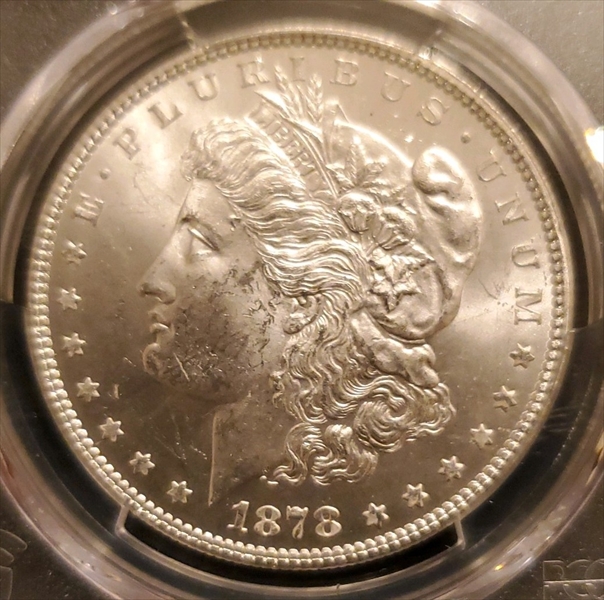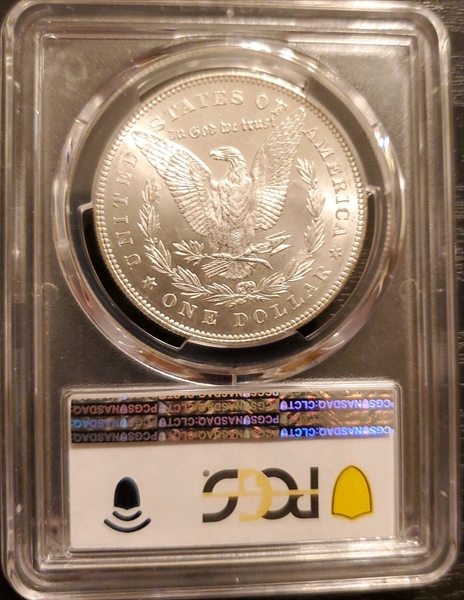1878 7TF $1 Reverse of 1878 MS63 认证号43330992, PCGS号7074
专家评论
Q. David Bowers
The following narrative, with minor editing, is from my "Silver Dollars & Trade Dollars of the United States: A Complete Encyclopedia" (Wolfeboro, NH: Bowers and Merena Galleries, Inc., 1993)Coinage Context
The final design: The 1878 7 tail feathers dollar represents the final design of the year.
Numismatic Information
Description of reverses: The 1878 7 tail feathers issue was struck in two major reverse variations:
The first is the Second Reverse, with 7 tail feathers, with parallel top arrow feather (P AF), and concave breast on the eagle. This is often referred as the Reverse of 1878. Striking time not known. Walter H. Breen estimated the production quantity at 4.9 million coins, while Wayne Miller suggested seven million as a more likely figure. My estimate is 7.2 million (based upon proportionate population reports and observed pieces).
The other 7 tail feathers issue is the Third Reverse, with slanting top arrow feather (SAF) and convex breast to the eagle. This is the Reverse of 1879. Walter H. Breen estimated the production quantity at 4.3 million coins; Wayne Miller suggested two million. My estimate is also two million (based upon proportionate population reports and observed pieces)
Walter H. Breen in his Encyclopedia gives estimated striking times for the various 1878 dollar issues, but this presupposes a first-in, first-out use of dies relative to their preparation times, a situation which may not be the case.
Morgan's 1877 pattern half dollars, and his pattern silver dollars of early 1878, all had seven tail feathers. Thus, this was the standard number, not a change from eight tail feathers. The 1878 8 TF was a variant.
Numismatic status: As of 1992, there is not a widespread interest in collecting 1878 7 tail feathers Morgan dollars by reverse varieties, although there is no reason why there shouldn't be. At present, many dealers do not differentiate the varieties when offering 1878 7 tail feathers dollars for sale, although the leading certification services identify them. I believe that when the new 3rd edition of the Van Allen-Mallis work (released in September 1992), achieves widespread distribution, interest in varieties of 1878 dollars will increase dramatically.
Hoard coins (of both reverse varieties): The 7 TF coins were not divided into Second and Third Reverse types until relatively recently. Thus, in numismatic literature there is no record of when one reverse or the other was released in quantity. It is known that the 7 TF dollar in general was distributed by the Treasury Department over a long period of time, from the year of striking onward. It has always been considered common. A group of bags came out of the Treasury in 1953, and for a while they were especially plentiful in dealers’ hands. Additional quantities of bags were paid out during the 1962-1964 Treasury release, especially during 1963, but no account was kept of them. In comparison to certain other issues, the quantities that came out in the early 1960s was small. Today, mint-sealed bags may not survive or are very rare.
SECOND REVERSE, REVERSE OF 1878, PAF:
Circulated grades (Second Reverse): This issue is very common in all circulated grades.
Mint State grades (Second Reverse): Most Mint State 1878 7 TF dollars are of the Second Reverse variety. Specimens are plentiful up to and including MS-64. Coins at the MS-65 level are elusive. My estimates are as fol1ows: MS-60 to 62,50,000 to 100,000; MS-63, 45,000 to 90,000; MS-64, 15,000 to 30,000; and MS-65 or higher, only 1,000 to 2,000.
Wayne Miller wrote this in 1982:
The 1878 7 tail feather flat breast [Second Reverse] dollar is usually adequately struck. However, because the breast of the eagle, by design, is flat and concave, the reverse may appear at first glance to be poorly struck. The typical specimen has poor lustre, but some pieces exhibit superb frosty surfaces, especially on the reverse. Bagmarks are much more prominent than usual and are the primary deterrent in locating a gem. This date is usually underrated In gem condition.
Miller went, on to say that this variety is not rare in prooflike condition, but that prooflike pieces are not particularly attractive, usually have heavy bagmarks, and relatively low contrast. However, "a very-few brilliant prooflike specimens exhibit superior lustre, with a spectacularly frosted eagle, and command  runaway price if minimally bagmarked."
Prooflike coins (Second Reverse): coins are sometimes prooflike on one side only. Gems are sometimes-seen and are rare. I estimate that 5,000 to 10,000 or so PL coins survive, of which (percertification service data) about 5% are MS-65 PL or higher DMPL coins are about twice as rare as PLs, and justa tiny number, perhaps 2% to 3%, are MS-65 OMPL or higher.
THIRD REVERSE: REVERSE OF 1879, SAF:
Circulated grades (Third Reverse): Readily available, but considerably scarcer than the preceding. Probably about 40,000 to 80,000 exist.
Mint State grades (Third Reverse): In Mint State the 1878 Third Reverse is scarcer at all levels than the Second Reverse. I believe that about 20,000 to 40,000 MS•60to 62 coins are known, followed by 12,500 to 25,000 MS-63, 6,000 to 12,000 MS-64, and only 400 to 800 MS•65 or finer pieces.
In his 1982 book, Wayne Miller wrote this:
It is much rarer in Uncirculated condition than the flat breast variety. Probably less than 20% of all Uncirculated 1878 7 tail feather dollars are of the Round Breast type. The lustre on such pieces is usually good. The strike varies from soft to adequate; few pieces are boldly struck, especially on the reverse. Specimens with minimum abrasions are available. This date has always been underrated In gem condition. Until recently there were, few collectors of silver dollar varieties, and the Round Breast and Flat Breast type Could often be purchased for the same price. In recent years; however, major dollar varieties have become more popular. The price of the 1878 7 tail feather Round Breast dollar has begun to rise to reflect this increasing interest."
Prooflike coins (Third Reverse): Examples are much rarer than of the Second Reverse type, and usually have poor contrast. I estimate that 1,000 to 2,000 PLs survive, of which only 2% to 3% are MS-65 PL or better; and that 600 to 1,200 DMPLs remain, again with just a tiny percentage being MS-65 DMPL or finer.
Varieties
Circulation strikes:
1. Second Reverse: Flat breast on eagle, parallel top arrow feather (PAF): Long nock (arrow shaft). Normal obverse, Breen-5509, VAM-70; doubled obverse, Breen-5510, several varieties. Long nock has a narrow tip extending minutely beyond adjacent feather tips; short nock has none. Gems and/or prooflikes are uncommon among 7 tail feather P AF coins of any variety; DMPLs more so.
2. Second Reverse: Flat breast on eagle, parallel top arrow feather (PAF): 1878 Short nock. Normal obverse, thin LIBERTY, Breen-55 11 , VAM-100. Scarce. Doubled obverse, at least 31 varieties, Breen-5512. Normal obverse, thick LIBERTY, at least a dozen varieties, Breen-5513. At least 100 Proofs (VAM-131), possibly 200, struck before March 31 (probably March 26) belong to this last number; many were melted or spent. The coiner sent to Linderman a Proof of the new coinage (7 tail feathers P AF) on April 4. The hub chipped at right of TRUST. On the earliest dies this letter is normal; on some later dies right serif is incomplete; on the last ones it is missing: "TIUST." (For the chipped serif, see 1878 S VAM-2, 14, 1879-S VAM-5; for the missing serif, see 1878-P VAM-160, 1879-S VAM-6, 8-10.)
3. Third Reverse: Reverse of 1879. Convex or round breast on eagle, slanting top arrow feather (SAF): Issue of June 28-December 31. (4.3 million-business strikes + 50- Proofs.) No lines in wheat leaves, normal obverse, Breen-5514, VAM-210, 221, 223. Although some test strikings were made circa March and April 1878, it is thought that masters and dies were shelved until later, so that the supply of 8 TF dies could be used up.
4. Third Reverse. Doubled obverse: Breen-5515, VAM-200, 201, 220. No lines in wheat leaves. Gems are uncommon, prooflikes a little more so (mostly one-sided), the small number of DMPLs mostly mediocre as with next.
5. Third Reverse: Reverse of 1879. Convex or round breast on eagle, slanting top arrow feather (SAF): Lines in wheat leaves. Breen-5516; VAM-202, 203, 222, 230. Mint State coins can be attractive, but prooflikes and DMPLs seen are generally of unsatisfactory quality.
SECOND REVERSE, PARALLEL ARROW FEATHER:
Circulation strike mintage. Second Reverse, P AF: 7,200,000
Estimated quantity melted. Second Reverse, P AF: Unknown
Availability of prooflike coins. Second Reverse, PAF: Prooflike coins are rare. Many prooflike coins are prooflike on one side only.
Characteristics of striking. Second Reverse, P AF: Usually average, although sharp pieces exist.
Known hoards of Mint State coins. Second Reverse, PAF: Few if any significant hoards remain today.
Specimens were paid out by the Treasury over a long period of years culminating in 1962-1964.
THIRD REVERSE, SLANTING ARROW FEATHER:
Circulation strike mintage. Third Reverse, SAF: 2,000,000
Estimated quantity melted. Third Reverse, SAF: Unknown
Availability of prooflike coins. Third Reverse, SAF: Scarce prooflike. When seen, the contrast is usually poor.
Characteristics of striking. Third Reverse, SAF: Usually seen weak to average.
Known hoards of Mint State coins. Third Reverse, SAF: Few if any significant hoards remain today. Specimens were paid out by the Treasury over a long period of years through 1962-1964.
Commentary
The 1878 7 TF exists in two main varieties. The style with slanting top arrow feather (Reverse of 1879) is the scarcer of the two, and in Proof state is the rarest before 1921. The first publication of the Second and Third Reverse was apparently by George W. Rice in the June 1898 Numismatist.
PCGS #
7074
设计师
George T. Morgan
边缘
Reeded
直径
38.10 毫米
重量
26.73 克
铸币数量
9759300
金属成分
90% Silver, 10% Copper
更高评级数量
4956
评级较低的钱币数量
7059
地区
The United States of America
价格指南
PCGS 数量报告
拍卖 - PCGS 评级的
拍卖 - NGC 评级的
稀有性和存量估计 了解更多
| 所有评级 | 175000 |
| 60或以上 | 100000 |
| 65或以上 | 1200 |
| 所有评级 | R-1.9 |
| 60或以上 | R-2.0 |
| 65或以上 | R-4.9 |
| 所有评级 | 33 / 117 TIE |
| 60或以上 | 65 / 117 TIE |
| 65或以上 | 45 / 117 TIE |
| 所有评级 | 33 / 117 TIE |
| 60或以上 | 65 / 117 TIE |
| 65或以上 | 45 / 117 TIE |




























